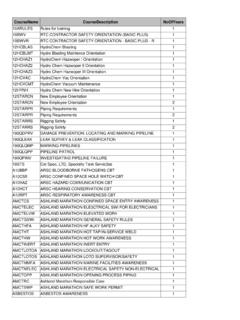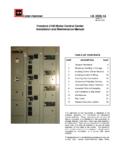Transcription of Lift-truck training: Advice for employers
1 Page 1 of 7 Health and safety ExecutiveLift- truck trainingAdvice for employersThis is a web-friendly version of leaflet INDG462, published 03/13 IntroductionLift trucks are widely used for moving materials and goods, but they are involved in about a quarter of all workplace transport accidents. The deaths and injuries caused can ruin lives and businesses. Even when an incident does not cause injury, it can still mean costly damage to lift trucks, buildings, fittings and goods. This leaflet is aimed at employers and those responsible for the safe operation of lift trucks, as well as those in control of worksites, the self-employed, managers and supervisors. Employees and their safety representatives may also find it an employer you are required to provide basic training and testing for all Lift-truck operators you employ (both new and existing).
2 Properly trained operators can reduce the risk of Lift-truck accidents in your operator in this leaflet is anyone who operates a lift truck , even as a secondary or occasional part of their job, not only those whose job title is Lift-truck lawThe Provision and Use of Work Equipment Regulations 1998 (PUWER) place certain requirements on employers . You must make sure that all people who use, supervise or manage the use of work equipment have received adequate training , which includes:the correct use of the equipment; any risks from its use; the precautions to take. If you are self-employed, you need to do the same type of training , and achieve the same standard, as employers are required to provide to their Code of Practice (ACOP) for Lift-truck operator trainingThis leaflet summarises the main points on operator training from the HSE Approved Code of Practice (L117) Rider-operated lift trucks: Operator training and safe use.
3 Approved Code of Practice and guidance (see Find out more ). L117 covers the training requirements for operators of stacking rider-operated lift trucks. Rider-operated means any truck capable of carrying an operator and includes trucks controlled from both seated and stand-on positions, which may be fixed or fold-away. Health and safety ExecutiveLift- truck training Page 2 of 7 The ACOP text in L117 does not cover straddle carriers, pedestrian-operated trucks and non-lift trucks fitted with removable attachments which modify their function, allowing them to be used temporarily as lift trucks, although you must still provide suitable training for those who operate can use the detailed guidance in L117 as an indication of the standard of training to provide for all lift should you train?
4 Potential Lift-truck operators should be:reasonably fit, both physically and mentally, to safely control and operate lift trucks, with the learning ability and potential to become competent operators; reliable, with a responsible attitude to their work; physically capable you should assess this on an individual basis. You may need to get medical Advice and make reasonable adjustments to enable some disabled people to work as Lift-truck operators. The Equality Act 2010 is likely to apply;over the minimum school-leaving age (16), except in ports, where they must be at least 18 years old, unless they are undergoing a suitable course of training , properly supervised by a competent person.
5 Children under 16 should never operate lift trucks. Look at Consulting employees You are legally required to consult all your employees, and listen to what they say, on health and safety matters, including the best ways to provide information and training . Look at Consulting employees on health and safety for more information (see Find out more ).What should training include?Operator training should always include three stages:Basic training . Specific job training . Familiarisation training . Basic trainingBasic training should cover fully all the skills and knowledge needed to safely operate the type of lift truck and handling attachments (if any) the trainee will use, including awareness of the risks from Lift-truck operation.
6 It should take place off the job , without the pressures of production. It is difficult to specify how long a course should last as many things affect the rate of learning, eg the ratio of trainees to instructors, but a course for a novice operator would typically last 3-5 days. See Basic training : Objectives to consider (taken from Appendix 1 in L117) on page should continuously assess a trainee s progress to ensure they achieve the required standards throughout training . At the end of the training , the trainee should pass a test, or tests, to demonstrate that they have the necessary practical and theoretical knowledge and skills to operate lift trucks safely. Appendix 2 of L117 includes suggestions for testing operator skills after basic and safety ExecutiveLift- truck training Page 3 of 7 Basic training : Objectives to consider After basic training , the trainee should be able to do the following.
7 State the reasons for operator training , the risks associated with Lift-truck operations and the causes of Lift-truck the responsibilities of operators to themselves and others, including their duties under the Health and safety at Work etc Act 1974 (HSW Act) to take reasonable care of their own health and safety and that of other people and co-operate with employers and others to help them comply with their legal the basic construction and main components of the lift truck , stating its principles of operation and load-handling capabilities and , as appropriate, handling attachments which may be used with the lift and state the purpose of all controls and instruments and how to use them.
8 Place the forks or other handling attachment in predetermined positions using the appropriate various forms of load, and state the procedures for their stacking, destacking and separation; assess the weight, and, where relevant, the load centre of a load; and decide if the load, with its known weight and load centre, is within the truck s actual capacity (safe working load).State the factors which affect machine stability, including: turning, especially the speed and sharpness of turn; load security and integrity; rated capacity and rated load centres; centres of gravity; ground conditions; and speed and smoothness of operation. Follow correct procedures when loading and unloading vehicles.
9 Make visual checks to ascertain the safety , soundness and rating of structures designed to receive loads, and place and remove loads on and from those structures at various up and place loads, and drive and manoeuvre the machine forward and in reverse, laden and unladen, on inclines, in restricted spaces and on level ground (including rough terrain as applicable), following correct procedures and the machine, following correct procedures and precautions. Where applicable state the purpose, and demonstrate how to use, safety devices including stabilisers, level indicators, and load indicators, if fitted, including the importance of using seat out inspection and maintenance tasks appropriate to operators as required by the machine manufacturers (including pre-shift checks) and any relevant what to do in an emergency while in control of a lift truck , eg if there is a why it is essential to have vehicle key custody arrangements.
10 Health and safety ExecutiveLift- truck training Page 4 of 7 Specific job trainingSpecific job training will normally follow the completion of basic training , but may be combined or integrated with it. It will be tailored to your particular needs and include, where appropriate:knowledge and understanding of the operating principles and controls of the lift truck to be used, especially relating to handling attachments and loads specific to the job (to be repeated when the design of truck is changed);routine inspection and servicing of that truck , in accordance with the operator s handbook or manufacturer s instructions, which may reasonably be carried out by the operator (to be repeated when the design of truck is changed);using the truck in conditions the operator will meet at work, eg gangways; loading bays; racking; lifts; automatic doors; confined areas.















